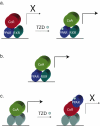Nuclear receptor corepressors and PPARgamma
- PMID: 16604166
- PMCID: PMC1402213
- DOI: 10.1621/nrs.04003
Nuclear receptor corepressors and PPARgamma
Abstract
The nuclear receptor corepressors NCoR and SMRT repress gene transcription by recruiting a histone deacetylase complex. Their roles in PPARgamma action have been controversial. Recent evidence, however, suggests that NCoR and SMRT repress PPARgamma-mediated transcriptional activity on specific promoters in the adipocyte. In addition, by repressing PPARgamma action, these corepressors inhibit the ability of adipocyte differentiation to proceed. A further understanding of corepressor action in the adipocyte will provide insight into the balance of forces regulating adipogenesis, insulin sensitivity, and Type 2 diabetes mellitus.
Figures

Similar articles
-
The nuclear receptor corepressors NCoR and SMRT decrease peroxisome proliferator-activated receptor gamma transcriptional activity and repress 3T3-L1 adipogenesis.J Biol Chem. 2005 Apr 8;280(14):13600-5. doi: 10.1074/jbc.M409468200. Epub 2005 Feb 3. J Biol Chem. 2005. PMID: 15691842
-
The optimal corepressor function of nuclear receptor corepressor (NCoR) for peroxisome proliferator-activated receptor γ requires G protein pathway suppressor 2.J Biol Chem. 2015 Feb 6;290(6):3666-79. doi: 10.1074/jbc.M114.598797. Epub 2014 Dec 17. J Biol Chem. 2015. PMID: 25519902 Free PMC article.
-
Nuclear receptor repression: regulatory mechanisms and physiological implications.Prog Mol Biol Transl Sci. 2009;87:235-59. doi: 10.1016/S1877-1173(09)87007-5. Epub 2009 Oct 7. Prog Mol Biol Transl Sci. 2009. PMID: 20374706 Review.
-
Nuclear corepressor and silencing mediator of retinoic and thyroid hormone receptors corepressor expression is incompatible with T(3)-dependent TRH regulation.Endocrinology. 2001 Dec;142(12):5321-31. doi: 10.1210/endo.142.12.8531. Endocrinology. 2001. PMID: 11713232
-
The Role of Histone Deacetylase 3 Complex in Nuclear Hormone Receptor Action.Int J Mol Sci. 2021 Aug 24;22(17):9138. doi: 10.3390/ijms22179138. Int J Mol Sci. 2021. PMID: 34502048 Free PMC article. Review.
Cited by
-
At the Crossroads of the Adipocyte and Osteoclast Differentiation Programs: Future Therapeutic Perspectives.Int J Mol Sci. 2020 Mar 26;21(7):2277. doi: 10.3390/ijms21072277. Int J Mol Sci. 2020. PMID: 32224846 Free PMC article. Review.
-
SMRT Regulates Metabolic Homeostasis and Adipose Tissue Macrophage Phenotypes in Tandem.Endocrinology. 2020 Oct 1;161(10):bqaa132. doi: 10.1210/endocr/bqaa132. Endocrinology. 2020. PMID: 32770234 Free PMC article.
-
Structural Basis of PPARγ-Mediated Transcriptional Repression by the Covalent Inverse Agonist FX-909.J Med Chem. 2025 Aug 28;68(16):17587-17597. doi: 10.1021/acs.jmedchem.5c01252. Epub 2025 Aug 12. J Med Chem. 2025. PMID: 40797371 Free PMC article.
-
Structural Biology Inspired Development of a Series of Human Peroxisome Proliferator-Activated Receptor Gamma (PPARγ) Ligands: From Agonist to Antagonist.Int J Mol Sci. 2023 Feb 15;24(4):3940. doi: 10.3390/ijms24043940. Int J Mol Sci. 2023. PMID: 36835351 Free PMC article. Review.
-
Controlling a master switch of adipocyte development and insulin sensitivity: covalent modifications of PPARγ.Biochim Biophys Acta. 2012 Jul;1822(7):1090-5. doi: 10.1016/j.bbadis.2012.03.014. Epub 2012 Apr 4. Biochim Biophys Acta. 2012. PMID: 22504298 Free PMC article. Review.
References
-
- Agostini M., Gurnell M., Savage D. B., Wood E. M., Smith A. G., Rajanayagam O., Garnes K. T., Levinson S. H., Xu H. E., Schwabe J. W., Willson T. M., O'Rahilly S., Chatterjee V. K. Tyrosine agonists reverse the molecular defects associated with dominant-negative mutations in human peroxisome proliferator-activated receptor γ. Endocrinology. 2004;145:1527–38. - PubMed
-
- Chen J. D., Evans R. M. A transcriptional co-repressor that interacts with nuclear hormone receptors. Nature. 1995;377:454–7. - PubMed
-
- Cohen R. N., Brzostek S., Kim B., Chorev M., Wondisford F. E., Hollenberg A. N. The specificity of interactions between nuclear hormone receptors and corepressors is mediated by distinct amino acid sequences within the interacting domains. Mol Endocrinol. 2001;15:1049–61. - PubMed
-
- Gurnell M., Wentworth J. M., Agostini M., Adams M., Collingwood T. N., Provenzano C., Browne P. O., Rajanayagam O., Burris T. P., Schwabe J. W., Lazar M. A., Chatterjee V. K. A dominant-negative peroxisome proliferator-activated receptor γ (PPARgamma) mutant is a constitutive repressor and inhibits PPARgamma-mediated adipogenesis. J Biol Chem. 2000;275:5754–9. - PubMed
LinkOut - more resources
Full Text Sources
Other Literature Sources

